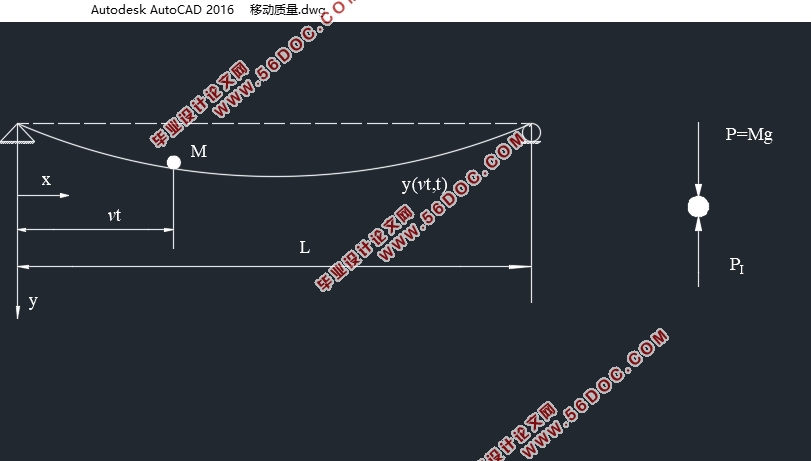基于ANSYS的钢筋混凝土简支梁桥车桥耦合分析(开题报告,外文翻译,论文说明书18000字)
摘要
近年来,随着桥梁跨度的不断扩大和桥墩高度的不断增高,以及桥梁结构复杂程度的加深和车辆行驶速度的提高,车辆与桥梁之间的相互作用也越来越大,车桥耦合振动问题已经成为公路桥梁设计工作中不可忽略的问题。所谓车桥耦合振动就是在桥面上行驶的车辆产生振动,而桥梁也会产生振动,两者各自的振动又会相互作用、相互影响,产生车桥系统的振动。车辆的动力作用会引起桥梁结构的振动,从而改变其受力性能,可能使结构构件产生疲劳,而降低了其强度和稳定性,从而影响桥梁的使用寿命;而桥梁的振动又会反过来对车辆的运行安全和舒适度产生影响。
本文以西固大桥为工程背景,取其跨中截面改造建立两座等截面箱型简支梁桥,开展了车桥系统的耦合振动分析。本文首先介绍了车桥系统耦合振动分析的理论知识,其次基于大型有限元分析软件建立了桥梁力学模型和车辆模型。其中桥梁模型和车辆模型的建立都是在ANSYS下完成,通过ANSYS读入TXT文件命令流方式完成建模过程。然后对简支梁桥的ANSYS动力分析进行了简要的介绍。最后对路面不平顺因素进行了讨论,得到了路面不平顺沿着路面走向的曲线。
综合本文研究,可以得到以下结论。
(1)通过对桥梁不同车辆模型的对比分析可以看出,文中几种车辆模型都可以体现出车桥耦合振动的基本振动特性;
(2)从瞬态分析中得到的时程曲线图可以看出当车辆行驶到接近桥梁跨中位置时梁桥此时的振动是最严重的,动挠度也是最大的;
(3)通过在车桥系统中引入不同等级的路面不平顺样本,得出路面不平顺度是影响车桥耦合振动的重要的激励因素。
关键词:简支梁桥;ANSYS;车桥耦合振动分析;有限元分析;生死单元
Abstract
In recent years,withthe continuous increasing of bridge span and the increasing of pier height, as well as the deepening of bridge structure complexity and the increasing of vehicle driving speed, the vehicle –bridge interaction is becoming more and more important, and the coupling vibration of vehicle and bridge has become an important problem in highway and bridge design work. The so-called vehicle-bridge coupling is the interaction between the vehicle on the bridge deck and the bridge. The dynamic action of the vehicle will cause the vibration of the bridge structure, thus changing its stress performance, which may cause fatigue to the structural member, and reduce its strength and stability, thus affect the service life of the bridge. The vibration of the bridge will in turn affect the safety and comfort of the vehicle.
Taking the Xigu Bridge as the engineering background, this paper takes its cross section box type simply support beam bridge, and carries out the coupling vibration analysis of the vehicle-bridge system. This paper firstly introduces the theoretical knowledge of the coupling vibration analysis of the vehicle-bridge system, and then establishes the bridge mechanics model and the vehicle model based on the large finite element analysis software. The bridge model and vehicle model are all completed under ANSYS, and the modeling process is completed by reading TXT file command and flow through ANSYS. Then the ANSYS dynamic analysis of simply supported Beam Bridge is briefly introduced. Finally, the influence of the coupling vibration analysis of the vehicle-bridge system is analyzed from the angle of pavement irregularity.
Compositing the study of this paper the conclusionscan be obtained as follows.
(1) Through the comparison and analysis of different vehicle models, it can be seen that several vehicle models can reflect the basic vibration characteristics of the coupling vibration of the bridge.
(2)The time curve obtained from the transient analysis show that when the vehicle is approaching the bridge, the vibration at this time is the most serious and the dynamic deflection is the biggest.
(3) By introducing different grades of road roughness samples in vehicle-bridge system, it is concluded that road roughness is the most important motivating factor affecting the coupling vibration of vehicle and bridge.
Key Words:Simply supported Beam Bridge;ANSYS;Analysis of vehicle-bridge coupling vibration;Finite element analysis;Life and Death unit.


目录
第1章绪论 1
1.1 引言 1
1.2公路桥梁车桥系统的耦合振动研究发展情况 1
1.2.1 国外公路桥梁车桥耦合振动研究发展 1
1.2.2 国内公路桥梁车桥耦合振动研究发展 2
1.3 应用ANSYS的思路 2
1.4 本文研究内容 3
1.5 本章小结 3
第2章车桥耦合振动的基本理论 4
2.1 移动荷载作用下的振动 4
2.2 移动质量作用下的振动 6
2.3 移动车辆(单轴单自由度)模型作用下的振动 9
2.4 本章小结 11
第3章 ANSYS模型的建立 12
3.1 工程概述 12
3.2 桥梁力学模型的建立 12
3.2.1等截面双箱简支梁桥模型的建立 12
3.2.2 等截面单箱简支梁桥模型的建立 13
3.3车辆模型的建立 14
3.4 本章小结 15
第4章简支梁桥的ANSYS动力分析 16
4.1 桥梁振动方程 16
4.2 车辆振动方程 16
4.3 车桥耦合方程 17
4.4 单元选取 17
4.4.1 BEAM 188单元 17
4.4.2 MASS 21单元 18
4.4.3 COMBIN 14单元 18
4.4.4SOLID 95单元 18
4.5 本章小结 18
第5章瞬态分析与生死单元法 19
5.1 ANSYS中瞬态分析的求解方法 19
5.2 荷载在ANSYS模型中的添加 20
5.3 生死单元法在ANSYS中的应用 20
5.4 本章小结 21
第6章路面不平顺的数值模拟 22
6.1引言 22
6.2 路面不平顺与功率谱密度 22
6.2.1 路面不平顺的定义 22
6.2.2路面不平顺的功率谱密度 22
6.3 路面输入频域模型 24
6.4 路面不平顺的数值模拟 25
6.4.1 离散傅里叶变换法 25
6.4.2 三角级数法 30
6.5 本章小结 34
第7章结论与展望 35
7.1 结论 35
7.2 需要改进之处和进一步研究的建议 35
主要参考文献 37
致谢 39
|





